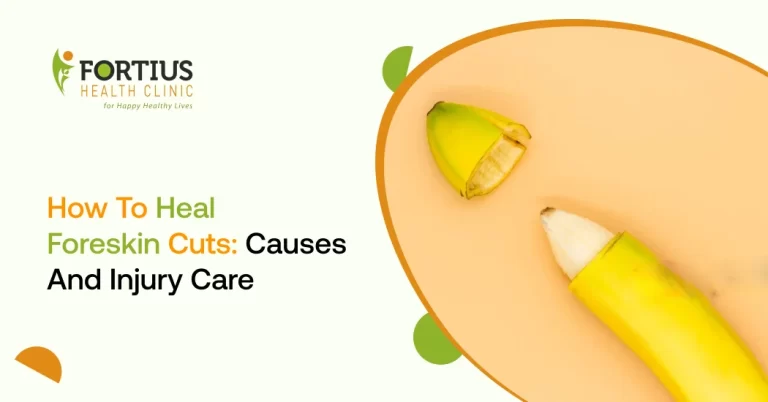
How To Heal Foreskin Cuts: Causes and Injury Care
Foreskin is a layer that protects the head of the penis from external irritants. It plays an important role in male anatomy, so any complications down there could be uncomfortable and painful. Normally, everyone feels very awkward. But, no worries. Continue reading to learn more about the causes of the cuts, injury care, and medical treatments.
Friction, scratching, and some awkward accidents could cause cuts on the foreskin. The cuts on the foreskin can mostly be treated at home using basic first aid and following proper hygiene. Depending on the severity of the cause of the cuts, you may require medical treatments.
What are the causes of cuts on my foreskin?
Foreskin cut happens for numerous reasons. Even some awkward accidents could cause the cut. Some of the most common causes are,
- Rough Sexual Activity
- Improper Personal Hygiene
- Dry Skin or Skin Conditions (e.g., Eczema, Psoriasis)
- Friction from Clothing
- Accidental Trauma
- Masturbation with Excessive Force
- Phimosis and Paraphimosis
Rough Sexual Activity
Excessive friction or lack of lubrication can stretch or damage foreskin tissue during intercourse. So, to avoid cuts caused due to rough sexual activity, use adequate lubrication and take breaks if needed. Avoid sexual activities until cuts heal.
Improper Personal Hygiene
Smegma buildup can result in skin weakness, irritation, and infection. To maintain hygiene, wash gently daily with water and avoid using harsh soaps.
Dry Skin or Skin Conditions
Dry or inflamed skin is more prone to minor cuts and cracks. To avoid this, apply a fragrance-free moisturizer or consult a doctor if your underlying skin conditions worsen. (e.g., Eczema, Psoriasis)
Friction from Clothing
Tight or rough clothing materials can irritate and cut the foreskin. To avoid friction from garments, wear loose, breathable clothing to minimize friction.
Accidental Trauma
Physical injuries from sports, mishaps, or mishandling objects can lead to foreskin cuts. Avoid rough handling and seek medical help if the injury is severe.
Masturbation with Excessive Force
Aggressive handling without lubrication can cause small tears. Use a water-based lubricant to reduce friction and be gentle while masturbating.
Phimosis and Paraphimosis
Phimosis and Paraphimosis is a condition where the foreskin is tight or gets stuck, which can lead to cuts when pulled forcefully. To treat this condition, seeking medical advice is better. Your doctor may recommend gentle stretching exercises or surgery like circumcision or frenuloplasty.
Medical Causes of Foreskin Cuts and Treatments
Some of the cuts caused on the foreskin are linked to medical conditions. It would be best if you had a thorough understanding of the medical causes, and targeted treatment approaches are necessary. Here are some of the most common medical causes and treatments that are mostly used to treat them.
- Balanitis
- Sexually Transmitted Infections (STIs)
- Lichen Sclerosus
- Diabetes-Related Skin Changes
- Contact Dermatitis
Balanitis
Balanitis is an inflammation of the glans and foreskin that often results from infections, poor hygiene, or irritants like soaps. When the foreskin becomes inflamed, it can swell and crack, making cuts more likely to occur.
Treatment options for treating cuts caused by Balanitis
- Topical Antifungals or Antibiotics: If Balanitis is caused by a fungal or bacterial infection, antifungal creams (like clotrimazole) or antibiotics can reduce the inflammation, which in turn helps prevent further cuts.
- Hygiene Improvements: Clean the area gently with warm water daily to prevent infection buildup. Avoid soaps or any harsh products that might worsen inflammation.
- Steroid Creams: Your doctor may prescribe mild steroid creams to reduce inflammation and minimize skin cracking, allowing cuts to heal.
Sexually Transmitted Infections (STIs)
Some STIs such as syphilis or herpes can result in ulcers or sores on the foreskin. When these sores rupture or heal, they can create cuts or small tears in the skin.
Treatment options for treating cuts caused by STIs
- Antiviral or Antibiotic Medication: Antivirals (for herpes) and antibiotics (for syphilis) can help control the infection, reducing the risk of further sores that lead to cuts.
- Avoid Irritating Activities: Refrain from sexual activities until the sores and cuts have healed to prevent worsening the condition.
- Regular Check-ups: Consistent follow-up with a healthcare provider can help manage outbreaks, keep the skin healthy, and reduce the recurrence of cuts.
Lichen Sclerosus
Lichen sclerosis is a chronic skin condition that causes patches of the thin, delicate skin on the foreskin. This skin is highly susceptible to tears or cuts, especially with movement or friction.
Treatment options for treating cuts caused by Lichen Sclerosus
- High-Potency Steroid Creams: These creams reduce inflammation and strengthen the skin, making it less likely to tear.
- Regular Moisturizing: Use non-scented, gentle moisturizers to keep the skin hydrated and prevent cracking.
- Surgical Intervention: In severe cases, circumcision might be recommended to prevent further tearing if lichen sclerosus continually causes cuts.
Diabetes-Related Skin Changes
High blood sugar levels in diabetics can result in poor circulation and dry, fragile skin, including on the foreskin. This makes the foreskin more likely to crack and tear with minimal friction.
Treatment options for treating cuts caused by Diabetes
- Blood Sugar Control: Managing blood sugar is crucial to improving skin health overall reducing dryness and fragility.
- Use Barrier Creams: Apply a barrier ointment or fragrance-free moisturizer to keep the foreskin soft and resilient.
- Antibiotic Creams for Infection: Diabetics are prone to infections, so using antibiotic creams on cuts can prevent complications and promote healing.
Contact Dermatitis (Allergic Reaction)
Contact dermatitis occurs when the foreskin reacts to irritating substances, such as certain soaps, lotions, or latex. The irritation weakens the skin, making it more susceptible to cuts.
Treatment options for treating cuts caused by Contact Dermatitis
- Identify and Avoid Irritants: Discontinue the use of any new products or potential allergens (like certain condoms) that may have caused the reaction.
- Apply Mild Steroid Creams: Over-the-counter hydrocortisone can reduce inflammation and itching, promoting healing.
- Barrier Ointment: Applying a protective ointment can shield the skin from further irritation, allowing the cuts to heal naturally.
Takeaway
Foreskin is a very sensitive part of the body with several nerve endings. So, a cut on the foreskin could cause discomfort and pain. But in most cases, the cut on the foreskin can be treated naturally at home or by following proper hygiene. If the cut on the foreskin is due to a medical cause, then consulting with a male sexologist or urologist is necessary. In severe cases, doctors recommend surgeries like circumcision. Contact Fortius Health Clinic for foreskin removal surgery or treating cuts on the foreskin.






